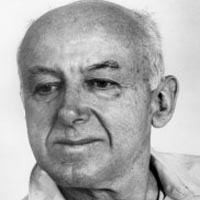Henry Cowell

Henry Cowell (1897-1965), was born in Menlo Park, California. The “godfather of the American experimental tradition” (in the words of Alex Ross), got an early start. While still young Cowell’s mother encouraged him to purchase a piano and, something of a child prodigy, he would give private recitals featuring his early compositions, including Anger Dance (1914).
At the age of 17, he went to study music with Charles Seeger (later husband of Ruth Crawford Seeger) at Berkeley before going on to work with Leo Ornstein in New York. His first work exploring tone clusters, Dynamic Motion, was composed in 1916. Later works developing this technique include Advertisement (1917) and Tiger (1930). Cowell’s other influential developments include experiments with what he termed “string piano”, where the player manipulates the strings inside the piano, rather than using the keys, as well as innovations in rhythm and harmony. Cowell’s compositions had a profound impact on several composes including Bartók, Conlon Nancarrow and John Cage, the last of whom credited Cowell as a contributor to his infamous prepared piano.
Cowell was close friends with a number of his contemporaries, including composers Carl Ruggles, Leo Ornstein, Ruth Crawford, and Charles Ives, on whose work Cowell would publish the first major study in his later life. In 1927 he founded New Music Edition, which included submissions from Ives, Ruggles, Schoenberg, Varése, and Webern. His career was interrupted in 1936 when he was convicted on a “morals” charge and sentenced to fifteen years in prison. While serving what would eventually be a four year sentence at San Quentin, he taught other inmates, led the prison band, and continued to compose, several works of which were specifically written for performance by those in the prison.
Cowell was paroled in 1940 and moved to New York, where continued to compose, pursuing his interests in folk music and incorporating non-western musical traditions into his works (Ongaku in 1957, Symphony No. 13 “Madras”, 1956-8, Homage to Iran, 1959). He married Sidney Robertson in 1941, an ethnomusicologist he had known since he was 14 and who had been instrumental in securing his release. He traveled extensively and continued to teach until his death in 1965.
Virgil Thomson perhaps best summarized Cowell’s contribution to music by writing: “Henry Cowell’s music covers a wider range in both expression and technique than that of any other living composer. His experiments begun three decades ago in rhythm, in harmony, and in instrumental sonorities were considered then by many to be wild. Today they are the Bible of the young and still, to the conservatives, “advanced.”… No other composer of our time has produced a body of works so radical and so normal, so penetrating and so comprehensive. Add to this massive production his long and influential career as a pedagogue, and Henry Cowell’s achievement becomes impressive indeed. There is no other quite like it. To be both fecund and right is given to few.”
For more information on Henry Cowell:
Joel Sachs: Henry Cowell: A Man Made of Music >>
Henry Cowell: Giving Us Permission (an essay by Peter Garland) >>
Henry Cowell: A Man Made of Music (WQXR special feature) >>
Henry Cowell Organization >>
